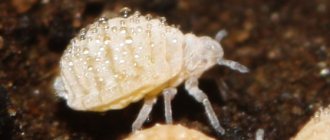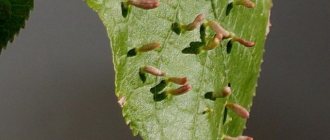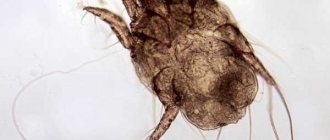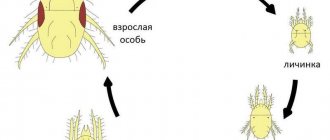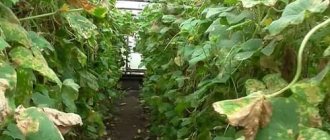The cyclamen mite is a garden and vegetable pest. It also attacks many indoor plants and feeds on their sap. Destroyed by insecticides.
The cyclamen mite is a garden and vegetable pest. It also attacks many indoor plants and feeds on their sap. Destroyed by insecticides.
Description:
The cyclamen mite is a pest that usually lives in gardens and vegetable gardens. Houseplants are also a welcome dish for him. And the inhabitants of balcony flower beds are affected by this pest quite often. True to its name, the cyclamen mite prefers to attack cyclamen. However, he will not refuse to settle on the young shoots and leaves of Saintpaulia, Balsamine, and Pelargonium.
The insect sucks the sap of plants, which can lead to their death. In a warm and humid microclimate, which Saintpaulia and some varieties of Cyclamen so need, this pest develops especially quickly.
This is one of the main reasons why the cyclamen mite is especially dangerous for indoor plants. Don’t forget about its microscopic size: the pest can only be seen with a magnifying glass
Signs:
Due to the small size of the cyclamen mite, its presence is most often recognized only by the result of the active activity of the pest.
If the plant begins to grow slower, the tips of the leaves begin to curl, the buds wither, and the young shoots curl - it’s time to sound the alarm.
If grayish pollen is found on the underside of the leaves, the suspicions are confirmed. The plants were attacked by the cyclamen mite.
Control measures:
If the indoor collection has been damaged by the cyclamen mite, insecticides must be used to destroy the pest . The most effective will be Actellik with pirimiphosmethyl as an active ingredient, Actara with triamethox and other drugs with a similar effect.
Unfortunately, on leaves heavily damaged by the cyclamen mite, it is not always possible to completely destroy insect colonies. The only method that remains to be applied in this case is to remove all leaves, shoots, and buds that have been heavily subjected to unauthorized attack.
After such pruning, the plant must be treated with chemicals. With proper care, he has a chance to recover.
Subscribe to new articles in the Garden section and receive updates by email. Expert articles on gardening care are understandable and accessible to everyone!
Description and differences
Cyclamen or strawberry mites (lat. Phytonemus pallidus) are distinguished by their smallest sizes (100-250 microns), so they can only be examined with a microscope. According to the classification, they do not belong to insects, but to arthropods of the arachnid class.
Mites have a translucent light yellow body and 4 pairs of legs; they live on young shoots of green shoots and in buds. Their main diet consists of plant cell sap. In addition to indoor flowers, they also attack garden strawberry and wild strawberry bushes, which is why they received their second name.
Ticks are capable of reproducing very quickly: each female lays 12-16 eggs daily, from which larvae appear within 3-7 days, they quickly mature and turn into adults within a week, ready to reproduce further.
The most important stimulator of their reproduction is dry air and warmth, which are a favorable environment for development. Therefore, the peak activity of cyclamen mites occurs in dry, hot weather in the summer months and during the heating period in winter.
If a mite is on a violet baby
The peak activity of ticks occurs during dry, hot weather in the summer or during the heating season in the cold season. They cannot cause much harm to adult healthy plants, but they can do it to young children. This is where you need to use acaricides - drugs against ticks. Dilute the drug in accordance with the instructions, spray rooted leaves with children and seated children. As a rule, one treatment is enough for the small plant to become stronger and mites no longer pose a threat to it. You can’t bathe “babies” the same way as adult specimens, and it’s problematic, they can catch a cold and get sick with gray rot. After spraying, place the babies in the warmest place. No covering with plastic bags, they will definitely rot there! You can place them under a table lamp with a low-power incandescent light bulb at such a distance as not to burn you; to check, you need to hold your hand in this place; if you feel a pleasant, gentle warmth, then you can place the plants.
Author of the article Rusinova T.A.
Read on the Gesneriev forum
Signs of damage to violets
You can determine that parasites have settled on indoor plants by the following external signs (see photo of mites on violets):
- the appearance of a “dusty” coating in the folds of young green leaves, in the nascent buds and in the apical shoots of violets;
- the growth of the flower slows down and its deformation occurs, the leaves turn yellow, fade and become brownish-gray, then curl;
- leaves and petioles become brittle and dry;
- the buds wither and fall off before they have time to open;
- Long hairs appear on young leaves, which signal the appearance of the cyclamen parasite.
Cyclamen mite on violets
If such signs of mites are detected on violets, cyclamen and other house plants, it is necessary to immediately isolate them from other flowers. Then you need to start treating it.
How can you tell if there are mites on a violet?
As a rule, violets are attacked by strawberry, cyclamen, transparent and greenhouse varieties of mites. All of them belong to the same family - tarzonemids. These creatures prefer high humidity. They parasitize mainly in the central parts of rosette-type plants, so streptocarpus and violets are under threat. In addition, there are also separate varieties of soil mites, which, when air humidity increases, begin to come out and damage flowers.
According to many experts, the plant can be affected by individuals of not just one type, but several varieties. So no particular poison can completely eradicate them. To get rid of pests, you need to create conditions for them so that they want to change their environment. The environment must be unfavorable for their reproduction.
To determine that a plant is affected by mites, you need to pay attention to the presence of the following signs:
- In the center of the rosette the leaves begin to twist. They become more brittle and then stop growing altogether. This indicates that the violet was attacked by a cyclamen-type mite.
- Pollen spills from the anther onto the petals. You may notice that the anthers themselves are slightly damaged, but if you carefully examine them through a magnifying glass, you will not be able to notice the parasites. This is a symptom that the violet has been infected by mites from the tarzanemid group.
- Violet leaves are compacted in some places; when palpated, a rough surface is felt on their villi. This indicates the presence of egg laying of any type of mite.
- The leaves droop, and this symptom is more pronounced than under other conditions.
- The leaves become dull. It seems as if they are sprinkled with ash or dandruff. A grayish or brownish tint appears. The stems become shorter. This can be a symptom of strawberry, cyclamen, or any other type of mite.
- Leaves become too brittle. The same applies to petioles.
- The buds either do not bloom at all or begin to fall off. This is due to the presence of tarzonemides.
- On the leaves there are noticeable many dots of a lighter shade than the leaf itself. These are places where parasites bite through tissue. If part of the flower is severely affected, it gradually loses color and dries out.
Methods for controlling mites on flowers
The fight against cyclamen mite on violets can be done in various ways:
- use of folk recipes;
- use of chemicals.
Related article: List of plants starting with the letter I: indoor, garden and vegetable gardens
The most popular folk remedy is to immerse the affected violet bush in hot water at a temperature not lower than 45°C. All affected parts of the flower must first be removed. The duration of the “bathing” is 15 minutes, but it is necessary to maintain a constant water temperature at the desired level.
After the water procedure, the bush is placed in a shaded place to allow it to recover for several days. Then it can be returned to its original place.
Use of chemicals
The first step in treating mites should be the complete elimination of all affected parts of the plant and infected flower stalks. Then it is necessary to wipe the leaves and other green parts of the violet using acaricidal agents: Actofit, Fitoverm, Akarin, Agravertin. To completely get rid of ticks, the procedure must be repeated every 3 days, and then every 5 days. If the damage is severe, it is recommended to completely dip the violet bush into a solution with acaricide or avermectin agents.
Popular chemical insecticides have no effect on ticks at all. Arthropods very quickly develop resistance to the poison, and it does not destroy their eggs - they can remain viable for several years.
Chemical measures to combat ticks involve frequent changes of drugs to increase the effectiveness of the fight and reduce addiction to them. Therefore, treatment with acaricides should be carried out in several stages, changing the drug each time.
Such drugs as Kleschevit, Antiklesch, Neoron, Sunmite, Omite have a good effect on ticks. However, the treatment should be carried out in a non-residential area, and after spraying the violets should be covered with polyethylene for 8-24 hours.
Chemical pest control
Due to the high toxicity of these drugs, it is necessary to use personal protective equipment (respirator, gloves and protective clothing).
Precautions when processing violets:
- Do not prepare the solution in containers intended for food;
- there is no need to add soap, since alkalis are incompatible with avermectin products;
- all prepared solutions should be used quickly, and then the remains should be destroyed;
- Treatment cannot be carried out in a residential area - it is dangerous for the health of people and pets.
After processing and treatment, the violet bush must be quarantined, that is, isolated from healthy specimens. And only after 3-4 weeks, after the appearance of fresh shoots and the obvious absence of signs of mites, the flower can be moved to its usual place.
Treatment schemes for killing mites on violets
To shorten the time it takes for the larvae to emerge from the eggs and reduce the period of their development, it is necessary to maintain the air temperature above 20°C. The optimal option is 25°C. And this also applies to night time. Now you can act according to several schemes.
Here are the most popular ones:
- First scheme. This option is perfect for apartments, houses and other residential buildings. Acaricidal drugs Sunmite, Nissoran, and any other drugs from the avermectin category (for example, Vetimek, Akarin, Actofit, Fitoverm) are used. First you need to treat the leaves with Sunmite until they are completely wet. You will need 1 g of substance per 1 liter of water. This product kills all forms of ticks, not only adults, but also larvae and eggs. But, despite the high effectiveness of Sunmite, it is recommended to repeat the treatment using Nissoran after 5 days. You will need to dilute 0.5 g per 1 liter of water. In parallel, use avermectins at a rate of 10 ml per 1 liter. It is better not to use Sunmite again so that the pest does not get used to it.
- Second scheme. This option is also recommended for use in residential buildings. You will need Sunmite and Judo (Oberon). First you need to treat with Sunmite (1 g of product per 1 liter of water). Then, after 5 days, carry out the procedure again, but use the second drug at a consumption of 0.3 ml per 1 liter of water.
- Third scheme. This option is also suitable for living rooms. This scheme is used if it was not possible to purchase Sunmite. You will need drugs from the avermectin group, as well as Envidor, Oberon, Nissoran. It is necessary to mix avermectin with another remedy from the listed ones. Consumption rates are described above. Then spray twice (the second is required 5 days after the first procedure).
- Fourth scheme. This option is used only in non-residential enclosed spaces. Actellik is used. It has fumigation properties, that is, it evaporates quickly and actively. This is why good sealing of the room where the violets are located is necessary. And you will have to wait a week. It is recommended to pack plants in a plastic bag if their quantity is small. For a large collection, it is best to seal the room - seal all openings, ventilation passages, doors, windows. You will need to use Actellik at a rate of 3 ml per 1 liter of liquid. By the way, the processing may not be thorough. The product will evaporate, and this is enough to kill even hidden pests.
- Fifth scheme. This option is considered very simple, but at the same time the most dangerous. It is strictly forbidden to use such a scheme in living rooms. Marshall is used - a systemic insecticide with a pronounced acaricidal and nematicidal effect. The main active component of the product is carbosulfan. It is necessary to dilute the substance 3 ml per 1 liter of water. Spraying is fine. The treatment can be carried out not thoroughly, since the substance is quickly absorbed into the plant and then spreads to its other tissues.
Other types of ticks
Spider mites belong to the superorder Acariformes, with more than 1,200 species. The size of the parasites is less than 1 mm, the color is green in summer, and red in spring and autumn. The mite is a dangerous pest that attacks berry and fruit crops in the garden. Settles on the lower parts of leaves, covering them with small cobwebs. Small parasites suck out all the juices from violet shoots, which quickly leads to their browning and drying out. You can fight spider mites on indoor plants with acaricides and folk remedies.
The flat beetle mite on violets differs from others in its ovoid body shape and color (yellow-orange or brick). Such parasites settle on domestic ficuses, cacti, citrus fruits and other indoor plants. The leaves begin to wither, which leads to rapid death. Their danger lies in their adaptability to rapid reproduction at normal room temperature (+18...+24°C), due to which they are able to lay eggs all year round. Control is carried out using acaricidal chemicals.
Flat beetle mite on violets
Root or bulb mites - damage the underground parts of plants, mainly bulbous species (gladioli, tulips, orchids, etc.). They multiply at high air humidity, so the main preventive measure is to store the bulbs dry in a cool room at a humidity of up to 60%.
Preventing ticks
To avoid the proliferation of mites on violet bushes, you should create optimal and favorable conditions for them: timely feeding, watering, maintaining the required temperature and lighting conditions that are necessary for this species.
Weakened specimens are more likely to be attacked by parasites.
Experts recommend carrying out prevention in the form of regular bathing of violets in dry and hot times, and also not combining them in the room with other plants that are easily infected with parasites (roses, etc.).
Tips on how to properly wash violets:
- carry out the procedure only in running water, and not in a basin;
- hold the pot and violet in your left hand, holding the rosette between your middle and index fingers, and the other fingers holding the container itself;
- Direct a stream of water onto the underside of each leaf;
- do all procedures with your fingers, since sponges and rags only contribute to the spread of infection;
- try to prevent water from getting into the center of the outlet, onto the flowers and the container itself;
- if the violet is blooming, then it is permissible to use slightly warm water; if not, it is better to make it hotter (up to +40°C);
- Bathing should not be carried out if the leaves are rotten or there is a suspicion of rotting of the roots;
- you cannot bathe violets during the autumn-winter period in the absence of heating;
- After the water procedure, remove moisture with a soft paper napkin, moving from the center of the outlet.
Anti-mite treatment
How to treat: everything is simple and straightforward - the plant must be thoroughly sprayed with the preparation until it is “very wet”, so that not a single untreated square millimeter of surface remains on the entire plant, and not just on the leaves. Just like that, casually spraying on the leaves “for prevention” is an empty and useless exercise. In general, treatments for preventive purposes have the same basis and meaning as drinking medicine by a healthy person in order to prevent a disease. Drug treatments are not plant vaccination; they only make sense if a pest is present.
The frequency and frequency of treatments with avermectins and any preparations in general depend on the type of pest (the time of reproduction of the pest from egg to egg, the presence of periods of non-feeding of the larvae, etc. are taken into account). In turn, the development time of the mite depends on the ambient temperature, which must also be taken into account for the correct choice of treatment schedule. The minimum period between treatments is 3 days, selected at a temperature of about 30*C, when the mite reproduces as quickly as possible. At a temperature of about 20*C, treatments can be carried out after 5 days, but their number remains the same - at least three, and it is better to do four treatments. And, of course, treatments with avermectins lose their meaning at temperatures below 18*C, at which mites stop feeding and go into diapause.
By the way, when treating with Fioverm, it is reasonable to minimize the penetration of the drug into the soil; the roots, if the drug flows abundantly into the ground, may suffer from the alcohol contained in the drug.
Preserving beauty: the main pests of cyclamen and how to combat them
Cyclamen is a rather delicate flower that requires especially careful care and increased attention of owners to the emergence of diseases and pests.
This plant, unlike many indoor counterparts, does not stop growing and flowering in the winter, therefore it is attacked by insects even in the winter months.
The rest of the article will discuss the main diseases caused by various pests and methods of treating them.
What kind of plant is this?
Cyclamen has an interesting root shape. It is a flattened corm of a regular round shape. Its diameter is 15 cm. It has one growing point, and not several, like other indoor plants. How can you characterize the leaves? They are leathery, basal and heart-shaped. They grow on petioles, the length of which is 30 cm. The color of the leaves is dark green, and the pattern on them is grayish-silver.
When flowering on cyclamen, the buds of the original shape open. From the outside it seems that strange butterflies are perched on top of the leaves on the flower stalks. Why is this impression created? Because the buds are pointed and bent. They have a fringed shape. Depending on the type of cyclamen, the flowers can be purple, red or burgundy. Flowering duration is 3 months.
Attention! Although some gardeners consider cyclamen capricious, in fact it is not like that
It’s just important to follow some care requirements, and it won’t cause any trouble.
Reasons for the appearance of insects on a flower
The most common reasons for the appearance of pests on cyclamen are improper care and unfavorable conditions for keeping it.
- Pests attack the flower when the temperature, lighting and humidity are incorrect.
- Excessive or insufficient watering of plants, an incorrectly selected substrate, the presence of drafts, and unbalanced feeding also provoke the appearance of insect pests.
- Pests often enter a room on a flower purchased in a store. Therefore, it is so important to inspect all parts of the plant for insects before purchasing.
- In spring and summer, indoor flowers are often taken out onto the balcony and loggia, where they can also become infected with insects.
- Soil for replanting taken from open ground can be dangerous for the plant, as it may contain pupae and larvae of pests.
Related article: Indoor bushes and shrubs with names and photos
Main parasites: description, photos and fight against them
Aphids are the most common and annoying pest, which can be relatively easily dealt with if you immediately notice and take all the necessary measures to destroy it. Most often, aphids enter the plant from the street through a window or window during ventilation.
This is a small wingless insect 1.4 - 2.5 mm in length. The color of their body can be gray, green, orange and black. Aphids feed on sap from the soft tissues of cyclamen.
Most of all, insects love buds, young leaves and shoots of flowers.
Signs:
- The flower stops growing.
- The leaves begin to deform and curl, turn yellow and fall off.
- Buds and flowers begin to dry out and fall off.
- A sticky coating appears on all parts of the plant. Thanks to this liquid, a sooty black fungus forms on the underside of the leaf blades, which greatly impairs gas exchange and greatly spoils the entire appearance of cyclamen.
Fighting methods:
- Isolate cyclamen from other indoor flowers.
- Wash the plant under running warm water, wipe the leaves with a damp cloth dipped in soapy water.
- Treat with insectids: “Aktara”, “Aktellik”, “Confidor” or “Agravertin”.
- You can spray the plant with folk remedies: decoctions of onion peels, orange peels, Christmas tree needles, nettles, yarrow, etc.
Shchitovka
This is a very small insect, similar to a drop, with a diameter of 2 to 5 mm with a hard shell (shield), due to which it is often compared to a turtle. This parasite spreads throughout the plant: stem, leaves, buds.
The scale insect sucks the juices of the flower, depriving it of the microelements necessary for proper growth and development.
Adult female scale insects are motionless, and young larvae without shields actively move, crawling from one plant to another. They are difficult to detect in the early stages of plant infection, as they hide in leaf axils and under leaves and camouflage themselves as specks.
Males of this species are even more dangerous. Thanks to their wings, they fly, easily covering tens of meters and spreading the population to neighboring plants. They resemble lumps of white dust.
Weakened flowers that have an excess nitrogen content and have a metabolic disorder due to improper care are infected with scale insects:
- improper watering;
- insufficient lighting;
- too hot or cold air.
Signs:
- A sticky honeydew appears on the leaves of cyclamen.
- The leaves turn yellow and dry out. You can find out about other reasons for yellowing leaves and lethargy of flowers here.
- Young shoots stop growing.
- Flowers and buds fall.
Fighting methods:
- Clean the flower from insects using a cotton swab soaked in soapy water. It is necessary to carefully process all parts of the plant and remove all shields.
- Apply insecticides - Aktar or Bankol and place the plant under the film for 1 hour.
- This procedure must be repeated every 3-4 days for two weeks.
- Place the infected plant in quarantine, and wash the infected area thoroughly with soap and water.
Thrips
Quite often, cyclamens are attacked by thrips, small black insects about 2 mm long, which in their shape resemble a spindle and have growths in the form of bubbles on their legs. They are also gray and brown.
These pests attack the entire above-ground part of the plant: buds, flowers, leaves and stems. These are very hardy and persistent creatures and very ancient; some entomologists consider them to be the ancestors of bedbugs. Their appearance is promoted by hot air and low humidity.
Signs:
- Dots, dashes, punctures and small light spots are clearly visible on the leaves and stems.
- The plant becomes discolored.
- A grayish-brown tint appears on the upper side of the leaf blades, and brown-brown spots appear on the underside.
- The edges of the leaves are deformed and curled (for what reasons can leaves curl and what to do about it?).
- Flowers and buds wither, dry out and fall off.
Control measures:
- The diseased plant must be urgently isolated and transplanted into a new substrate, having previously washed the roots and tuber in a light solution of potassium permanganate.
- Treat cyclamen with insecticides: Aktara, Intavir, Aktelik, Fitoverm, Karbofos. Treatment should be carried out once a week, 3 times a day.
- Thrips cannot stand the smell of garlic, so you can spray the plant with the appropriate infusion or simply place cut cloves next to it.
Cyclamen mite
Microscopic insect 1-3 mm long. It has a yellowish body and 4 pairs of legs. Appears when the air is too dry and the temperature is too high.
Signs:
- A dusty coating appears on different parts of the plant, which is clearly visible in the folds of young leaves and on flowering buds.
- The edges of the sheet plates are deformed.
- The buds wither and drop.
- The stems are twisted.
Fighting methods:
- All affected buds, flowers and leaves are removed.
- Chemical preparations: “Fitoverm”, “Inta-vir”, “Decis”, “Iskra”, “Neoron”, “Kinmiks” or “Karate”.
- Folk remedies: ash-soap solution, infusions of potato tops, citrus peels, onion and garlic peels and others.
If time has already passed and the mite has multiplied greatly, you can try to save the plant by cuttings.
How to recognize a tick
I have been trying to grow violets since January 2011 . And still nothing. Let's look at my mistakes together and look for the reasons. We will draw conclusions and clearly understand what the problem might look like. How can I eliminate it? I will be glad if my experience is useful to someone.
The first flaws were attributed to my inexperience and violation of agricultural technology. At the same time, I, like all crazy violet growers, saw all the signs of a mite in violets. There are no exact descriptions of the signs of mite damage in the initial stage of the disease on websites about violets. And the signs themselves are similar to other flaws in cultivation. Mostly on the Internet, photos show already eaten rosettes with ugly leaves in the center. I didn't have any such horror stories.
The first year was spent selecting soil . In the next version, dolomite flour was added to the composition. The babies' leaves have become hard. They looked something like this.
I changed the composition of the soil, eliminating dolomite flour - the soil was based on coconut, peat, perlite, vermiculite. After transplanting, the violets moved a little and froze again. The leaves were twisted and distorted.
This is a baby Snow Edelweiss. Suffering.
We are nursing, but the suffering of Snow Edelweiss continues. Unpainted spots are visible on the upper leaves. Looks like a propeller. But this is not a sign.
Next, baby Summer twilight, April 2013. The middle is a little clogged and the leaves are a bit harsh. Everything was written off as a violation of agricultural technology.
I kept looking for a reason. And in order to eliminate all doubts about the mite, inspired by Lyudmila Milaya’s article, in April 2013 she treated all violets with Actofit according to the proposed scheme, 4 times with an interval of 3 and the last time - 5 days. I didn’t spray the rosettes, but dipped them completely into the solution. Both pots and window sills were treated.
Here is the same Snow Edelweiss plant after dressing, November 2013.
The bottom row of leaves of Snowy edelweiss 1,2,3 is crumpled, brittle, hard; 1- spots along the edge (as if from overflow), 4 leaves are underdeveloped. The new leaves are a joy.
Next is the already familiar Summer Twilight rosette, November 2013, after dressing with Actofit.
We observe different sizes, or rather underdevelopment, of leaves in the middle row. This was exactly the growth point at the time of etching in April 2013. The center has straightened out. For your information, the outlet in the photo is over a year old. And she still needs a 50g glass. Development... leaves much to be desired - it has never bloomed yet.
Next we look at LE Lunar Dreams, November 2013, after the April dressing with Actofit
The lower leaves are bitten, the lowest ones are underdeveloped. The new ones grow normally, but slowly. Again growth stopped.
After the April 2013 treatment with Actofit, I received a restful sleep and confidence that the tick was simply excluded from my small collection.
In December 2013, I again noticed a stunt in growth. Violets live on my windowsill without additional lighting. Increased hairiness appeared in the center of some rosettes. I decided that it was winter—the violets were sleeping. And fluffiness can also appear from dry air from the battery.
My suspicions were revived as a copy of the Pink Watercolor rosette took root. Here, see for yourself.
This photo is Pink watercolor, January 2014. More precisely, it is the crown that grew next to the missing growing point on the pickled stump of the mother plant. I cut it down and re-rooted it in November 2013. But it is in no hurry to grow. And those twisted leaves in the center...
Baby Frozen In Time, January 2014. The lower leaves are dying. The growth point became deformed and hardened. Growth has stopped.
Next exhibit. Also very suspicious. The leaves are twisted.
These are two Bukey Irish Lace babies, January 2014, grown from a leaf fragment. Liszt also thought for a long time and threw himself away prematurely. Let's move on.
This is baby Smoky Emerald, January 2014. It seems to be even, but the leaves are waxy.
Leaf of the Stone Flower, January 2014. Placed for rooting in a zip bag. An ideal environment for the development of “bugs” in the microclimate. Shown as an example because it has become completely hard—waxy. And this arouses suspicion - you know who’s presence...
Although, looking at the Stone Flower rosette itself (January 2014) you wouldn’t think:
Apart from two underdeveloped leaves marked in red in the middle row, there are no special signs of invasion. The leaves are not hard.
Not all sockets were affected. Some turned out to be tenacious and gave good growth after the April 2013 treatment.
This is the January 2014 Buckeye Elusive Stars rosette. Strong variety. The leaves are slightly curled in the middle, which can also happen due to dry air. It has one more dried up leaf and a peduncle that has been frozen since November 2013. Although, if I were in his place, I wouldn’t bloom in winter without additional lighting either. Let's look further.
Gardens of Babylon - the rosette has dried up after the growing point has disappeared. Treatment in April 2013 did not revive her. There is a leaf left and it is also waxy. The stalk has rotted and the top is drying out. There were suspicions of agricultural technology, a tick, and some kind of disease.
Finally, the most affected adult outlet is King's Ransom. Photo January 2014 (etched in April 2013).
It's hard to show. The mature lower row of leaves is not severely damaged and is not stiff. The middle row of leaves began to dry out in November 2013 and disappeared completely. The leaves in the center froze. Drying and dying are visible on the petioles near the stem.
Actually, this was the picture for the next decisive step.
All these deteriorations in the development of plants suggested the presence of uneaten or newly acquired living creatures. I read articles about ticks. I don't have a microscope. I took an ordinary magnifying glass and a flashlight.
I looked closely for a long time. And what do you think? How did I feel when I noticed a subtle movement on the cutting of the top leaf. A transparent, barely noticeable speck of dust was moving. I took a closer look. And there... there are many of the same, but immovable. A transparent greenhouse mite was identified. Their males move, the other stages do not.
photo taken from source: adenium-doma.ru/forum/7-6-1
Let's consider an object - a habitat for ticks.
Here, on the baby Buckeye Irish Lace, the fact of tick activity has already been established. Result - 1 leaf is hard, twisted, underdeveloped, 2 lower ones are flaccid - dies, 3 - has not grown.
In addition, upon further inspection, cheerfully frolicking gomazoid or putrefactive mites (larger and clearly visible under a magnifying glass and with the naked eye) were found on the soil. They were written in detail by the user Svetlana here
As for the rest of the plants examined, there is no doubt that all the problems are also the results of the mite’s life, but they just look different. Perhaps each plant reacts individually, so the symptoms are different for everyone. There is no big picture. It appears when it is impossible to save the rosette (it’s easier to grow an even one again).
And everything fell into place. This is after three years of trying. And spots and drying out, curling of leaves and increased pubescence and hard waxy leaves and slow growth and rotting of the root part of the stem and cuttings.
All these are my personal conclusions, perhaps yours will differ from mine.
I consider even a negative result as a positive experience.
I decided to strengthen the fight against it. We don't give up. We do not sell JUDO or Oberon. After reading the article on Dimetris, I purchased the drug Envidor with the active ingredient Spirodiclofen
Consumption rate is 6 ml per 10 liters of water. Does not have system properties. The action is only contact. Effective against all stages of females, has ovicidal properties (acts on eggs).
All plants were treated on January 08, 2014 with precautions using the immersion method. I diluted this 5 ml flask in 8 liters of filtered water. There is no smell. Does not leave stains on the leaves.
I don't advertise. I haven’t decided on the result yet - it takes time.
I warn you right away that you should not use this drug in the presence of children and animals.
We are waiting for spring. To be continued, as you yourself understand, to be continued.
Prevention of flower diseases
To avoid unpleasant situations with the appearance of pests on a flower, follow these rules:
- Carefully inspect existing and newly acquired plants for pests.
- Buy only healthy and high-quality planting material from trusted suppliers in specialized stores.
- Isolate damaged flowers from healthy plants.
- Disinfect dishes and soil before planting and replanting a flower.
- Significantly increase the resistance of cyclamens to pests by regular and proper watering, ventilation of the room, and proper feeding and lighting.
